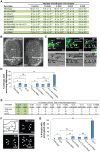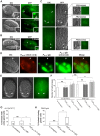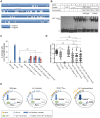LIN-3/EGF promotes the programmed cell death of specific cells in Caenorhabditis elegans by transcriptional activation of the pro-apoptotic gene egl-1
- PMID: 25144461
- PMCID: PMC4140636
- DOI: 10.1371/journal.pgen.1004513
LIN-3/EGF promotes the programmed cell death of specific cells in Caenorhabditis elegans by transcriptional activation of the pro-apoptotic gene egl-1
Abstract
Programmed cell death (PCD) is the physiological death of a cell mediated by an intracellular suicide program. Although key components of the PCD execution pathway have been identified, how PCD is regulated during development is poorly understood. Here, we report that the epidermal growth factor (EGF)-like ligand LIN-3 acts as an extrinsic signal to promote the death of specific cells in Caenorhabditis elegans. The loss of LIN-3 or its receptor, LET-23, reduced the death of these cells, while excess LIN-3 or LET-23 signaling resulted in an increase in cell deaths. Our molecular and genetic data support the model that the LIN-3 signal is transduced through LET-23 to activate the LET-60/RAS-MPK-1/ERK MAPK pathway and the downstream ETS domain-containing transcription factor LIN-1. LIN-1 binds to, and activates transcription of, the key pro-apoptotic gene egl-1, which leads to the death of specific cells. Our results provide the first evidence that EGF induces PCD at the whole organism level and reveal the molecular basis for the death-promoting function of LIN-3/EGF. In addition, the level of LIN-3/EGF signaling is important for the precise fine-tuning of the life-versus-death fate. Our data and the previous cell culture studies that say EGF triggers apoptosis in some cell lines suggest that the EGF-mediated modulation of PCD is likely conserved in C. elegans and humans.
Conflict of interest statement
The authors have declared that no competing interests exist.
Figures






Similar articles
-
The Caenorhabditis elegans synthetic multivulva genes prevent ras pathway activation by tightly repressing global ectopic expression of lin-3 EGF.PLoS Genet. 2011 Dec;7(12):e1002418. doi: 10.1371/journal.pgen.1002418. Epub 2011 Dec 29. PLoS Genet. 2011. PMID: 22242000 Free PMC article.
-
Conversion of the LIN-1 ETS protein of Caenorhabditis elegans from a SUMOylated transcriptional repressor to a phosphorylated transcriptional activator.Genetics. 2015 Mar;199(3):761-75. doi: 10.1534/genetics.114.172668. Epub 2015 Jan 7. Genetics. 2015. PMID: 25567989 Free PMC article.
-
Integration of EGFR and LIN-12/Notch Signaling by LIN-1/Elk1, the Cdk8 Kinase Module, and SUR-2/Med23 in Vulval Precursor Cell Fate Patterning in Caenorhabditis elegans.Genetics. 2017 Dec;207(4):1473-1488. doi: 10.1534/genetics.117.300192. Epub 2017 Sep 27. Genetics. 2017. PMID: 28954762 Free PMC article.
-
Vulval development.WormBook. 2005 Jun 25:1-28. doi: 10.1895/wormbook.1.6.1. WormBook. 2005. PMID: 18050418 Free PMC article. Review.
-
LET-23-mediated signal transduction during Caenorhabditis elegans development.Mol Reprod Dev. 1995 Dec;42(4):523-8. doi: 10.1002/mrd.1080420422. Mol Reprod Dev. 1995. PMID: 8607985 Review.
Cited by
-
Programmed cell death and clearance of cell corpses in Caenorhabditis elegans.Cell Mol Life Sci. 2016 Jun;73(11-12):2221-36. doi: 10.1007/s00018-016-2196-z. Epub 2016 Apr 5. Cell Mol Life Sci. 2016. PMID: 27048817 Free PMC article. Review.
-
Programmed Cell Death During Caenorhabditis elegans Development.Genetics. 2016 Aug;203(4):1533-62. doi: 10.1534/genetics.115.186247. Genetics. 2016. PMID: 27516615 Free PMC article.
-
Emerging roles of tsRNAs in programmed cell death and disease therapeutics: challenges, opportunities, and future directions.Noncoding RNA Res. 2025 Jul 11;15:65-73. doi: 10.1016/j.ncrna.2025.07.003. eCollection 2025 Dec. Noncoding RNA Res. 2025. PMID: 40809958 Free PMC article. Review.
-
SCAV-3 affects apoptotic cell degradation in Caenorhabditis elegans.FEBS Open Bio. 2023 May;13(5):867-880. doi: 10.1002/2211-5463.13599. Epub 2023 Apr 2. FEBS Open Bio. 2023. PMID: 36947094 Free PMC article.
-
Cell Death in C. elegans Development.Curr Top Dev Biol. 2015;114:1-42. doi: 10.1016/bs.ctdb.2015.07.018. Epub 2015 Sep 9. Curr Top Dev Biol. 2015. PMID: 26431562 Free PMC article. Review.
References
-
- Baehrecke EH (2002) How death shapes life during development. Nat Rev Mol Cell Biol 3: 779–787. - PubMed
-
- Lettre G, Hengartner MO (2006) Developmental apoptosis in C. elegans: a complex CEDnario. Nat Rev Mol Cell Biol 7: 97–108. - PubMed
-
- Potts MB, Cameron S (2011) Cell lineage and cell death: Caenorhabditis elegans and cancer research. Nat Rev Cancer 11: 50–58. - PubMed
-
- Sulston JE, Horvitz HR (1977) Post-embryonic cell lineages of the nematode, Caenorhabditis elegans . Dev Biol 56: 110–156. - PubMed
Publication types
MeSH terms
Substances
LinkOut - more resources
Full Text Sources
Other Literature Sources
Molecular Biology Databases
Research Materials
Miscellaneous

